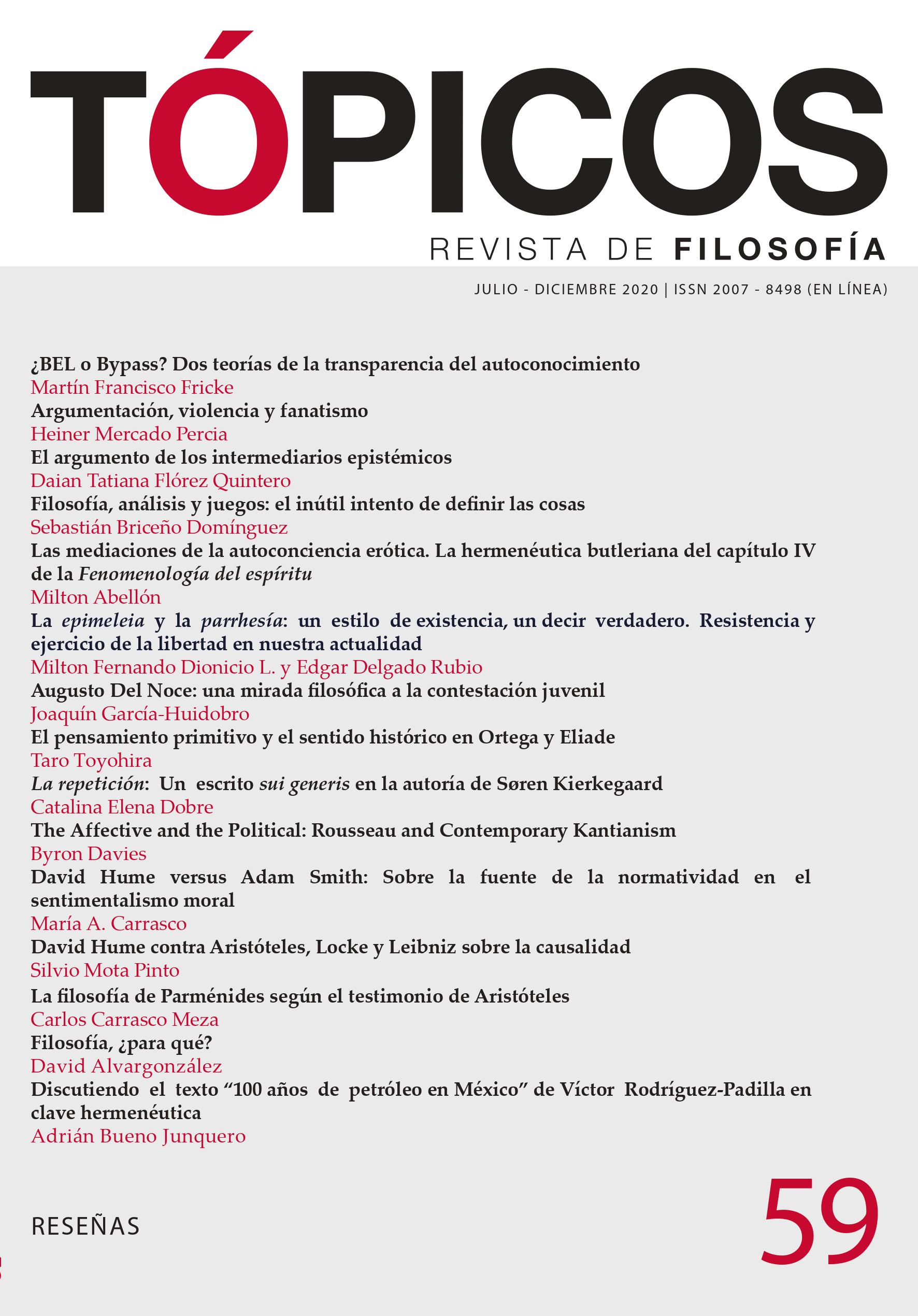Articles
David Hume Versus Adam Smith: On the Source of Normativity in Moral Sentimentalism
Published 2020-06-27
How to Cite
Carrasco, M. A. (2020). David Hume Versus Adam Smith: On the Source of Normativity in Moral Sentimentalism. Tópicos, Revista De Filosofía, (59), 341–366. https://doi.org/10.21555/top.v0i59.1114
Downloads
Download data is not yet available.
Altmetrics
Citas
Abstract
Despite the countless similarities between David Hume’s and Adam Smith’s moral theories, many people have lately argued that the Theory of Moral Sentiments can be read as a critical response to Hume’s ethics. In this paper I contend that the most important difference between these sentimentalist philosophers has to do with the source and nature of morality’s normative authority, which in turn determines what is a legitimate moral reason or what is morality properly speaking.
References
- Cohon, R. (2008). Hume’s Morality: Feeling and Fabrication. Oxford University Press.
- Darwall, S. (2006). The Second-Person Standpoint, Harvard University Press.
- Darwall, S. (2010). Precis: The Second-Person Standpoint. Philosophy and Phenomenological Research, 81(1), 216-228.
- Elton, M. (2017). Crítica de Thomas Reid al sistema de la simpatía de Adam Smith. Anuario Filosófico, 50(3), 503-526.
- Fleischacker, S. (2012). Sympathy in Hume and Smith: A Contrast, Critique and Reconstruction. En C, Fricke y D. Follesdal (eds.),
- Intersubjectivity and Objectivity in Adam Smith and Edmund Husserl. (pp. 273-311). Ontos Verlag.
- Hume, D. (1985). “Of the Standard of Taste”. En E. Miller (ed.), Essays: Moral, Political and Literary. (pp. 226-249). Liberty Fund.
- Hume, D. (1998). An Enquiry concerning the Principles of Morals. T. Beauchamp (ed.). Oxford University Press.
- Hume, D. (2007). A Treatise on Human Nature. D. F. Norton y M. J. Norton (eds.). Oxford University Press.
- Lingdren, R. (1973). The Social Philosophy of Adam Smith. Martinus Nijhoff.
- Martin, M. (1990). Utility and Morality: Adam Smith’s Critique of Hume. Hume Studies, 16(2), 107-120.
- Pack, J. S. y Schliesser, E. (2006). Smith’s Humean Criticism of Hume’s Account of the Origin of Justice. Journal of the History of Philosophy, 44(1), 47-63.
- Rasmussen, D. (2017). The Infidel and the Professor. David Hume, Adam Smith, and the Friendship that shaped Modern Thought. Princeton University Press.
- Reeder, J. (1997). On Moral Sentiments. Contemporary Responses to Adam Smith. Thoemmes Press.
- Russell, P. (1995). Freedom and Moral Sentiment. Oxford University Press.
- Sagar, P. (2017). Beyond Sympathy: Smith’s Rejection of Hume’s Moral Theory. British Journal for the History of Philosophy. 25(4), 681-705.
- Sayre-McCord, G. (1994). On Why Hume’s ‘General Point of View’ Isn’t Ideal and Shouldn’t Be, Social Philosophy and Policy, 11(1), 202-228.
- Sayre-McCord, G. (2013). Hume and Smith on Sympathy, Approbation and Moral Judgment, Social Philosophy and Policy, 30(1-2), 208-236.
- Schliesser, E. (2017). Adam Smith: Systematic Philosopher and Public Thinker. Oxford University Press.
- Smith, A. (1982). The Theory of Moral Sentiments. D. D. Raphael y A. L. Macfie (eds.). Liberty Fund.
- Stewart, C. (1976). The Moral Point of View. Philosophy, 51(196), 177-187.
- Strawson, P. F. (1974). Freedom and Resentment and Other Essays. Metheun & Co.
- Taylor, J. (2015). Reflecting Subjects. Passion, Sympathy and Society in Hume’s Philosophy. Oxford University Press.






